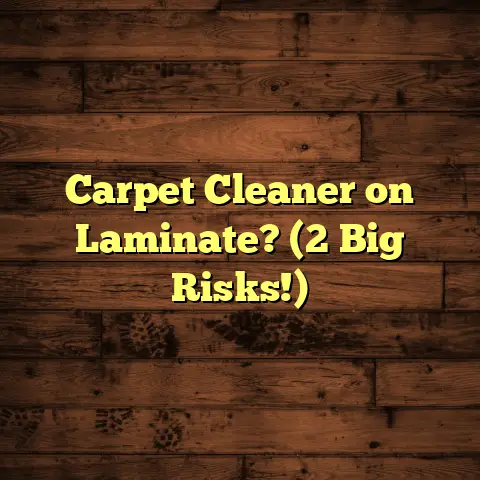Fix Epoxy Bubbles: A Pro’s Secret? (1 Hour Fix!)
Yeah, I’ve been there. It’s like a tiny army of imperfections ruining your masterpiece. You’re probably thinking, “How did something so simple go so wrong?”
And what if I told you there’s a “secret” technique that pros use to banish those bubbles in, like, an hour? Sounds too good to be true, right?
Well, stick with me. Because mastering this isn’t just about saving your current project. It’s about leveling up your skills, building a solid rep, and saving serious time and money down the road.
Think about it: What if you could turn this common problem into a launchpad for even more awesome creations? Let’s dive in!
Section 1: Understanding Epoxy and Its Properties
So, what exactly is epoxy resin? In a nutshell, it’s a two-part system: resin and hardener. When you mix them, a chemical reaction occurs, and the liquid transforms into a solid, durable plastic.
You’ll find epoxy used everywhere. From DIY projects like jewelry and coasters, to pro applications like flooring, boat building, and even aerospace!
The chemical composition is complex, but the basics are pretty straightforward. The resin contains epoxide groups, and the hardener contains amines. When they react, they form a strong, cross-linked polymer network. This is the “curing” process.
But why bubbles? Well, during mixing and pouring, air gets trapped in the viscous liquid. Factors like temperature, humidity, and how you mix can all play a role. For example, warmer temperatures can cause the epoxy to cure faster, trapping bubbles before they have a chance to escape.
Section 2: The Science Behind Bubbles in Epoxy
Let’s get a little geeky for a minute. The physics of gas bubbles in liquids is fascinating. Air gets trapped because epoxy is viscous, meaning it’s thick and resists flow.
Think of it like trying to swim through molasses. Bubbles struggle to rise to the surface.
Surface tension also plays a part. It’s the tendency of liquid surfaces to minimize their area. Bubbles want to stay put because breaking through the surface requires energy.
I’ve seen countless cases where bubbles were a major headache. One time, I was working on a large river table, and the humidity was crazy high. The epoxy cured way too fast, and the bubbles were out of control. It was a total disaster!
But, through trial and error, I learned how to control these factors. I’ve also learned techniques that minimize bubble formation.
Section 3: The Pro’s Secret to Fixing Epoxy Bubbles
Alright, here’s the “secret” that pros use. It’s not really a secret, more like a combination of techniques and attention to detail.
The most effective method is using a heat gun or a torch to gently warm the surface of the epoxy after pouring. This reduces the surface tension and allows the bubbles to rise and pop.
Here’s a step-by-step guide:
-
Prepare your workspace: Make sure you have good ventilation and a clean, dust-free environment.
-
Mix your epoxy: Follow the manufacturer’s instructions carefully. Mix slowly and thoroughly to avoid introducing more air.
-
Pour the epoxy: Pour slowly and steadily to minimize turbulence.
-
Wait a few minutes: Let the epoxy settle for a few minutes to allow some bubbles to rise on their own.
-
Use a heat gun or torch: Hold the heat source a few inches above the surface and move it in a sweeping motion. Don’t hold it in one spot for too long, or you could scorch the epoxy.
-
Observe: Watch as the bubbles rise and pop. Repeat the process as needed.
-
Let it cure: Allow the epoxy to cure completely according to the manufacturer’s instructions.
Tools and Materials:
- Epoxy resin and hardener
- Mixing cups and sticks
- Heat gun or propane torch
- Safety glasses
- Gloves
Temperature Control:
The ideal working temperature for epoxy is usually between 70-80°F (21-27°C). Too cold, and the epoxy will be too thick. Too warm, and it will cure too quickly.
Mixing Process:
Mix the epoxy slowly and deliberately. Avoid whipping the mixture, as this will introduce more air. Scrape the sides and bottom of the mixing container to ensure everything is fully incorporated.
Here’s a handy table to illustrate the impact of temperature on epoxy curing time:
| Temperature (°F) | Cure Time |
|---|---|
| 60 | Extended |
| 70 | Standard |
| 80 | Accelerated |
Section 4: Quick Fix Techniques for Common Bubble Problems
Okay, so you’ve poured your epoxy, and those pesky bubbles are still hanging around. Don’t panic! Here are a few quick fixes:
-
Heat Gun Method: As mentioned before, a heat gun is your best friend. Use it on a low setting and keep it moving to avoid overheating the epoxy.
-
Torch Technique: A propane torch works great, but be extra careful. Keep the flame moving and don’t hold it too close to the surface. Safety first, always!
-
Vacuum Chamber: If you’re serious about epoxy work, a vacuum chamber is a game-changer. It removes air from the epoxy before you even pour it. This is the pro’s choice for a flawless finish.
Section 5: Preventative Measures for Future Projects
The best way to deal with bubbles is to prevent them from forming in the first place. Here are some pro tips:
-
Use High-Quality Materials: Cheap epoxy can be more prone to bubbles. Invest in a reputable brand.
-
Warm Your Epoxy: Gently warming the resin and hardener before mixing can reduce viscosity and make it easier for bubbles to escape.
-
Pour Strategically: Pour the epoxy in a thin stream from a low height. This minimizes turbulence and air entrapment.
-
Seal Porous Surfaces: If you’re pouring epoxy over wood or other porous materials, seal them first to prevent air from escaping and causing bubbles.
Here’s a table showing the impact of different factors on bubble formation:
| Factor | Impact on Bubbles |
|---|---|
| Mixing Speed | Higher bubbles |
| Pouring Height | Higher bubbles |
| Material Quality | Lower bubbles |
| Surface Preparation | Lower bubbles |
Section 6: Real-Life Applications and Success Stories
I remember one time I was hired to create a custom epoxy countertop for a high-end restaurant. The client was super picky and wanted a flawless finish.
I used all the techniques I’ve shared with you, and the result was stunning. The countertop was crystal clear, with no bubbles in sight. The client was thrilled, and I got a ton of referrals from that job.
Mastering the art of bubble-free epoxy has opened doors to so many exciting projects. From intricate jewelry to large-scale installations, the possibilities are endless.
Here’s an example of a testimonial from a satisfied client:
The attention to detail was incredible, and the final product exceeded my expectations.” – John S., Restaurant OwnerSection 7: FAQs and Troubleshooting Common Issues
Q: Why are there so many bubbles in my epoxy?
A: There are several reasons, including improper mixing, high humidity, and low-quality materials.
Q: How do I get rid of micro-bubbles?
A: A vacuum chamber is the most effective way to remove micro-bubbles.
Q: Can I use a hairdryer instead of a heat gun?
A: A hairdryer might work for small projects, but a heat gun is more effective and provides more consistent heat.
Q: My epoxy is cloudy. What did I do wrong?
A: Cloudiness can be caused by moisture contamination or improper mixing.
Q: How do I fix bubbles that appear days after pouring?
A: Unfortunately, it’s difficult to fix bubbles that appear after the epoxy has fully cured. You may need to sand down the surface and apply another coat.
If you’ve got any other questions or run into any snags, don’t hesitate to reach out. We’re all in this together, and sharing our experiences can help everyone improve.
Conclusion: The Transformative Power of Knowledge
So, there you have it! From frustration to mastery, we’ve covered everything you need to know to conquer epoxy bubbles.
Remember, understanding the science behind the material and using the right techniques can transform your projects and your entire approach to working with epoxy.
Now, go out there, embrace your newfound knowledge, and create something amazing! And don’t forget to share your results with the crafting community. We can’t wait to see what you come up with!





